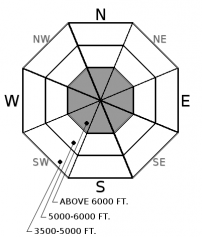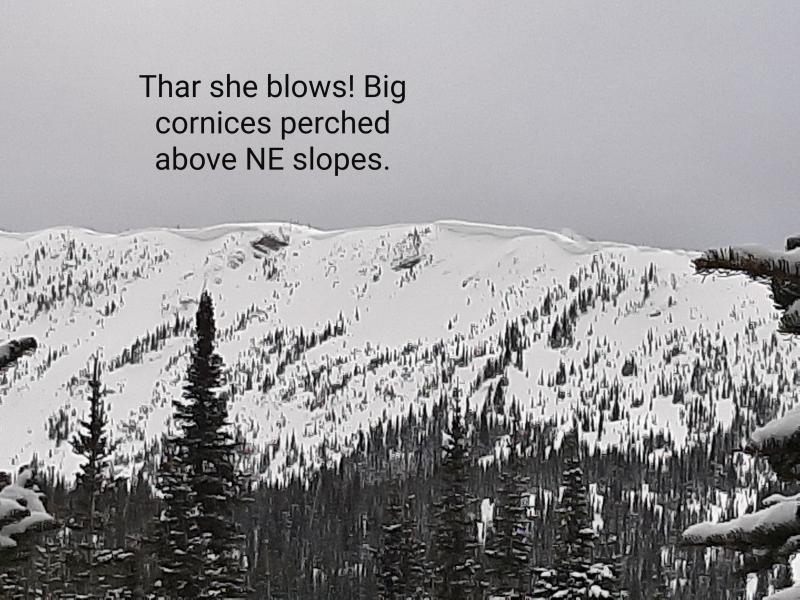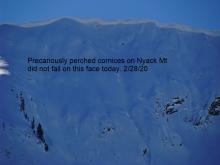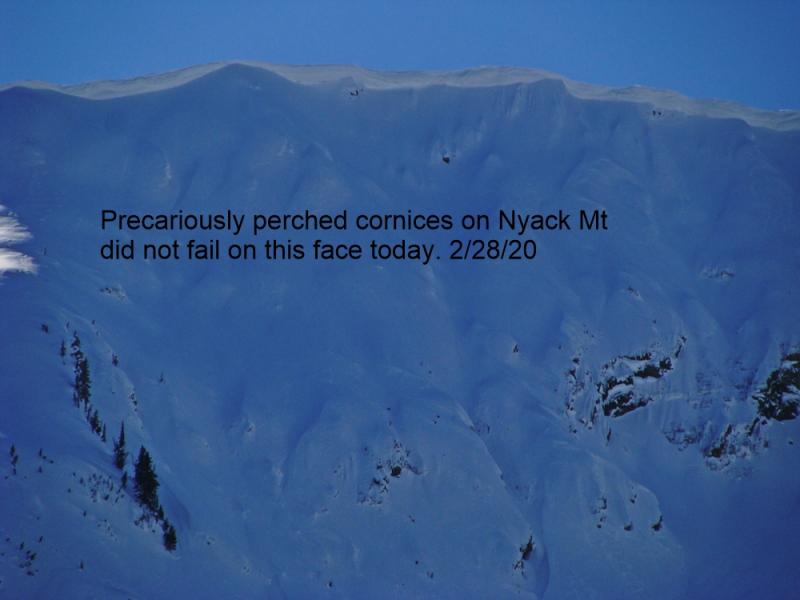| Friday | Friday Night | Saturday | |
|---|---|---|---|
| Cloud Cover: | Partly cloudy, increasing temperatures and winds throughout the day | Mild temperatures with increasing precipitation and winds | Warming temperatures with continued light precipitation and increasing winds |
| Temperatures: | 37-48 deg. F. | 28-37 deg. F. | 43-52 deg. F. |
| Wind Direction: | South | Southwest | Southwest |
| Wind Speed: | 5-7 | 10-13 gusts 23-25 | 15-17 gusts 37-40 |
| Snowfall: | 0 in. | 0-3 in. | 0 in. |
| Snow Line: |
Whitefish Range
Swan Range
Flathead Range and Glacier National Park
How to read the forecast
Freezing temperatures over the past 24 hours locked up the snowpack overnight. The avalanche danger will begin at LOW at all elevations. Warming temperatures and abundant sunshine will increase the avalanche danger to MODERATE above 5000 feet today. With an incoming system, be aware of warming temperatures and a spring mix of precipitation rapidly weakening the snow surface.

2. Moderate
?
Above 6500 ft.
2. Moderate
?
5000-6500 ft.
1. Low
?
3500-5000 ft.
- 1. Low
- 2. Moderate
- 3. Considerable
- 4. High
- 5. Extreme
-
Type ?
-
Aspect/Elevation ?

-
Likelihood ?CertainVery LikelyLikelyPossible
 Unlikely
Unlikely -
Size ?HistoricVery LargeLargeSmall

The loose, wet avalanche danger will start at LOW today and rise to MODERATE throughout the day. The brief, but thorough, freeze over the past 24-hours locked up much of the moist snowpack from the past week of warm temperatures and rain. Expect firm, suportable condtions this morning that will change as a warm, wet front moves into the area this afternoon. This new front should bring increasing temperatures (up to 40º F at 5000 feet) and a spring mix of precipitation. Expect loose, wet danger to increase on all aspects if the rain arrives sooner than forecasted. Look out for deteriorating riding and skiing conditions that indicate increasing avalanche danger. Obvious signs of loose, wet avalanche problems are moistening surface snow, rollerballs, and unsupportability (trenching of skis or snow machine). Be weary of sun-exposed slopes and changing weather during your day out. Keep in mind that even short, seemingly benign slopes can be dangerous when the effects of an avalanche are amplified by terrain traps like narrow gullies, cliffs, and trees.
-
Type ?
-
Aspect/Elevation ?

-
Likelihood ?CertainVery LikelyLikelyPossible
 Unlikely
Unlikely -
Size ?HistoricVery LargeLargeSmall

Winds and snowfall from storms earlier this month formed large cornices across our advisory area. Sun and warming temperatures will weaken these beasts today and it is best to give them a wide berth while traveling along ridgelines. BNSF Avalanche Safety observed cornice failures over the past week in John F. Stevens Canyon in southern Glacier Park. Also keep in mind that falling cornices can trigger avalanches on the slopes beneath them so it is important to minimize exposure to slopes where cornices loom above.
Spring can bring a mixed bag of weather conditions to northwest Montana. It can surprise us with intense snow squalls, warm temperatures, and rain-on-snow events (even in the same day). This makes it increasingly important to closely monitor changing conditions. With longer days and a higher sun angle, conditions can rapidly change.
In isolated areas a layer of weak sugary snow (facets) sitting on top of the Feb. 10th rain crust produced unstable results in stability tests. I suspect that a few natural avalanches that occured recently were associated with that interface. This illustrates the importance of digging into the snow and continuing to assess deeper instabilities particularly after a recent, substantial load. In most locations the Feb. 10 crust is buried 2.5 to 4 feet from the snow surface.
Thursday: Adam and Todd were on Tunnel Ridge in the Flathead Range. Temperatures started off warm , but rapidly decreased as a cold front moved into the area. Up to about 6000 feet they found that recent melt and rain water had percolated through the entire snow pack. At 7000 feet only the upper snowpack was moist. Along the ridgeline wind direction was variable with gusts to 45 mph, but only transporting snow on the highest surrounding peaks. WMR Ski Patrol reported natural loose, wet activity in the Skook Chutes with debris all the way to Canyon Creek. They suspected these avalanches to have run on Wednesday (3/15).
Wednesday: BNSF avalanche safety reported natural avalanche activity in the John F. Stevens Canyon. These loose, wet and wet slab avalanches were estimated at size 2-3 and a few reached the valley floor.
Tuesday: Seth, Todd and Jenny were in the Southern Whitefish Range near Ghoulie Point/Canyon Creek. Snow levels had reached over 6800 feet by the end of the day, rain was plentiful and the upper layers of the snowpack were becoming saturated. Rollerball and pinwheel activity was widespread and there was some cracking in the surface snow. Pits identified some weaknesses in the new snow, but no propagation occurred and no natural activity was observed. By afternoon, the warming and additional liquid precipitation was making it possible to trigger very small, wet loose avalanches on steep terrain.
See below for all observations this season.
After a couple of days of above freezing temperatures, a cold clear front pushed in yesterday and began to lock-up our snowpack. Most of the weather stations throughout our advisory area have recorded below freezing temperatures since ~8am yesterday morning. Winds were blustery yesterday (gusting up to 47mph on Snowslip) and calmed overnight. Today, expect warming temperatures, and increasing winds throughout the day. Another storm system should move into the area this afternoon and increasing precipiation and winds along with it. This warm wet front should persist through tomorrow bringing us a quality spring mix of weather.
| 0600 temperature: | 15-26 deg. F. |
| Max. temperature in the last 24 hours: | 31-36 deg. F. |
| Average wind direction during the last 24 hours: | Southwest |
| Average wind speed during the last 24 hours: | 10-20 mph |
| Maximum wind gust in the last 24 hours: | 25-47 mph |
| New snowfall in the last 24 hours: | 0-1 inches |
| Total snow depth: | 88-121 inches |
This advisory applies only to backcountry areas outside established ski area boundaries. This advisory describes general avalanche conditions and local variations always occur. This advisory expires at midnight on the posted day unless otherwise noted. The information in this advisory is provided by the USDA Forest Service who is solely responsible for its content.























